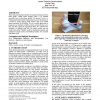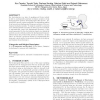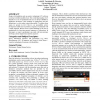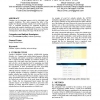ASSETS
2015
ACM
8 years 11 months ago
2015
ACM
In this paper we propose a computer vision-based technique that mines existing spatial image databases for discovery of zebra crosswalks in urban settings. Knowing the location of...
ASSETS
2015
ACM
8 years 11 months ago
2015
ACM
Three-dimensional printed models are important learning tools for blind people. Unlike tactile graphics, there is no standard accessible way to label these models. We present Talk...
ASSETS
2015
ACM
8 years 11 months ago
2015
ACM
While screen reading technologies offer considerable promise to individuals who are blind by providing an accessible overview of web-based content, difficulties can be faced deter...
ASSETS
2015
ACM
8 years 11 months ago
2015
ACM
The HandSight project investigates how wearable micro-cameras can be used to augment a blind or visually impaired user’s sense of touch with computer vision. Our goal is to supp...
ASSETS
2015
ACM
8 years 11 months ago
2015
ACM
Non-visual text-entry for people with visual impairments has focused mostly on the comparison of input techniques reporting on performance measures, such as accuracy and speed. Wh...
ASSETS
2015
ACM
8 years 11 months ago
2015
ACM
An electrolarynx is a type of speaking aid device which is able to mechanically generate excitation sounds to help laryngectomees produce electrolaryngeal (EL) speech. Although EL...
ASSETS
2015
ACM
8 years 11 months ago
2015
ACM
People with disabilities rely on assistive technology (AT) software to interact with their mobile device. The overall functionality of AT depends on a set of requirements that are...
ASSETS
2015
ACM
8 years 11 months ago
2015
ACM
People who are blind or visually impaired face difficulties using a growing array of everyday appliances because they are equipped with inaccessible electronic displays. We report...
ASSETS
2015
ACM
8 years 11 months ago
2015
ACM
In this work, we present a platform designed for children with Autism Spectrum Disorder to develop language and generalization skills, in response to the lack of applications tail...
ASSETS
2015
ACM
8 years 11 months ago
2015
ACM
Calendars can be important memory aids for individuals with cognitive disabilities. This study compared the effect of the popular two-dimensional table calendar view and the simpl...




